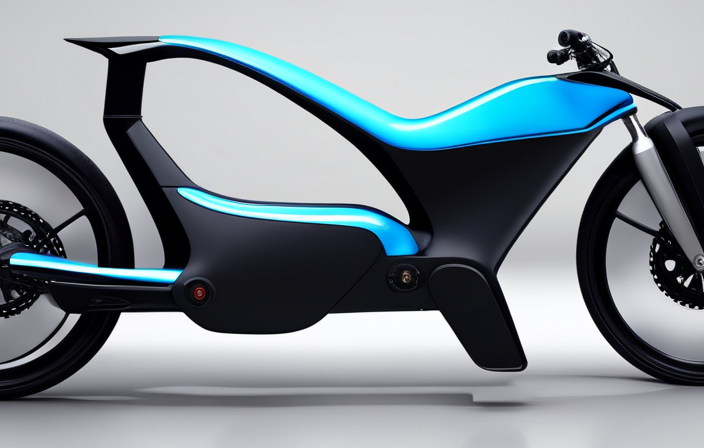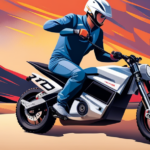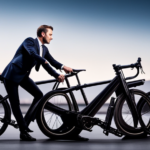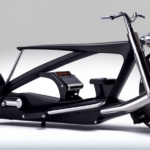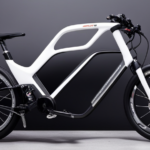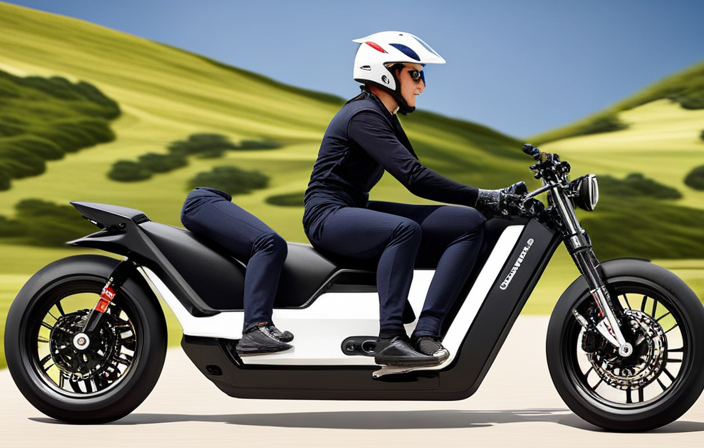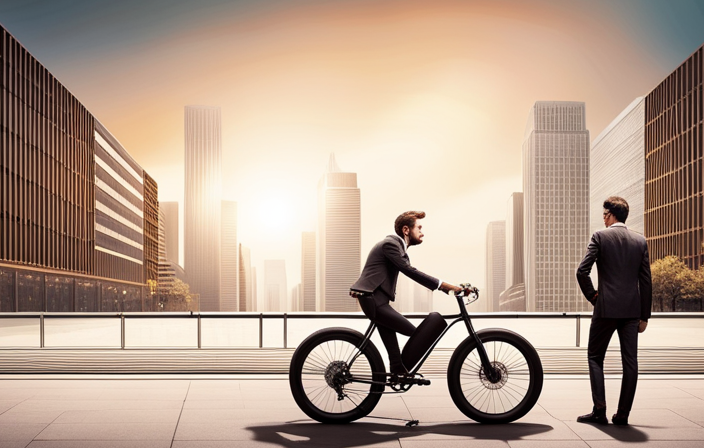Are you ready to take your cycling experience to electrifying heights? Get ready to witness the transformation of a regular bike into an electrifying powerhouse!
In this article, I will guide you through the essential parts needed to convert your bike into an electric one. From selecting the perfect motor and battery to ensuring a smooth ride with the right frame and wheels, we’ll cover it all.
So, fasten your helmet and prepare to embark on an electrifying journey like no other!
Key Takeaways
- Motor power and torque analysis are crucial in selecting the right motor for speed, maneuverability, acceleration, and climbing abilities.
- Battery capacity and charging options should align with specific needs and preferences to determine the range of the e-bike.
- Choosing a compatible controller, throttle, and display, with seamless integration, improves user interface, convenience, and power regulation.
- Upgrading the brake system and considering safety features such as regenerative brakes can enhance control and ensure safety while riding an electric bike.
Motor Selection and Installation
The first step in building an electric bike is selecting and installing the motor. When it comes to motor selection, there are a few key factors to consider.
One of the most important considerations is motor power. The power of the motor determines how fast and how easily the bike can navigate various terrains. It is crucial to choose a motor with sufficient power to meet your biking needs.
Additionally, torque analysis is essential when selecting a motor. Torque refers to the rotational force that the motor can generate. Higher torque allows for better acceleration and climbing abilities. By analyzing the torque requirements of your desired biking routes, you can choose a motor that will provide adequate power and performance.
Once the motor is selected, proper installation is crucial to ensure optimal functionality and safety of the electric bike.
Battery Options and Installation
To power an e-bike, you can choose from various battery options and easily install them. When selecting a battery, it is crucial to consider its capacity, which determines how far your e-bike can go on a single charge. Higher capacity batteries provide longer ranges but are generally bulkier and heavier.
Additionally, it is important to consider the charging options for your battery. Most e-bike batteries can be charged using a standard electrical outlet, but some models offer the convenience of removable batteries that can be charged separately. Another option is fast-charging, which allows you to quickly charge your battery in a shorter amount of time.
Ultimately, the battery you choose should align with your specific needs and preferences for your e-bike.
Controller and Throttle Setup
Before diving into the setup process, it’s important to understand how the controller and throttle work together on an e-bike. The controller is the brain of the electric bike, regulating the power flow from the battery to the motor. It determines the motor power and controls the speed of the bike. The throttle, on the other hand, is the interface between the rider and the controller. By twisting or pressing the throttle, the rider can control the speed of the bike.
When it comes to selecting a controller and throttle for your electric bike, it’s essential to consider your motor power and battery range. The controller should be compatible with the motor power of your e-bike to ensure optimal performance. Additionally, the throttle should be easy to reach and operate comfortably while riding. By choosing the right controller and throttle setup, you can enhance the overall riding experience and maximize the efficiency of your electric bike.
| Controller | Throttle |
|---|---|
| Regulates power flow | Controls speed |
| Determines motor power | Interface with rider |
| Compatible with motor power | Easy to reach and operate |
| Enhances riding experience | Maximizes efficiency |
Choosing the Right Frame and Wheels
When choosing the right frame and wheels for your e-bike, it’s important to consider factors such as durability, weight, and terrain.
The wheel size plays a crucial role in determining the ride comfort and handling of your electric bike. Smaller wheel sizes, like 26 inches, are commonly found on mountain bikes and provide better maneuverability and control on rough terrains. On the other hand, larger wheel sizes, such as 700c, are more suitable for road bikes as they offer higher speeds and smoother rides on paved surfaces.
Additionally, the frame material is another critical aspect to consider. Common frame materials for e-bikes include aluminum, steel, and carbon fiber. Aluminum frames are lightweight, durable, and corrosion-resistant, while steel frames offer strength and durability. Carbon fiber frames, although expensive, provide excellent stiffness and shock absorption, resulting in a smoother and more comfortable ride.
Brake Systems and Safety Features
Consider upgrading your brake system to ensure optimal safety and control while riding your e-bike.
When it comes to electric bikes, having a reliable brake system is crucial for your safety. Electric bikes are faster and heavier than regular bicycles, so it’s important to have brakes that can handle the increased speed and weight.
There are different types of brake systems available for electric bikes, such as mechanical disc brakes, hydraulic disc brakes, and regenerative brakes.
Mechanical disc brakes are the most common and affordable option, providing reliable stopping power. Hydraulic disc brakes offer even better performance and require less maintenance, but they are more expensive. Regenerative brakes are a unique feature found in some electric bikes, which use the motor to generate electricity and slow down the bike. This can help extend the battery life and provide additional control when braking.
Regardless of the type of brake system you choose, it’s important to also consider safety features such as integrated lights, reflective accents, and horn or bell to ensure that you are visible and can alert others of your presence on the road.
Electric Bike Conversion Kits
To upgrade your bicycle with an electric bike conversion kit, you’ll need to choose the right kit for your needs and make sure it includes all the necessary components. Electric bike conversion kits are a cost-effective way to transform your regular bike into an electric one. The cost of an electric bike conversion kit can vary depending on the brand and features, but it is generally more affordable than buying a new electric bike.
The benefits of electric bike conversion are numerous. Firstly, it allows you to keep your favorite bicycle and simply enhance it with electric power. This means you can enjoy the benefits of an electric bike without having to invest in a whole new bike. Additionally, electric bike conversion kits are easy to install and remove, allowing you to switch between electric and regular biking whenever you want.
Furthermore, converting your bike to electric power reduces your carbon footprint and promotes a more sustainable mode of transportation. Overall, electric bike conversion kits offer a convenient and eco-friendly way to experience the joys of electric biking.
Wiring and Electrical Connections
Make sure you have the proper wiring and electrical connections in place for your electric bike conversion kit. It is essential to ensure a smooth and efficient flow of electricity throughout your bike.
Here are three key aspects to consider for wire routing and wire management:
-
Wire Routing: Plan the path of your wires carefully to avoid any interference with moving parts or potential damage. Keep the wires away from areas with high heat, sharp edges, or excessive vibrations.
-
Wire Management: Use zip ties or cable clamps to secure the wires neatly along the frame. This not only prevents tangling but also protects them from external elements such as dirt, water, or accidental pulling.
-
Proper Insulation: Insulate all wire connections using heat shrink tubing or electrical tape. This ensures a secure and safe connection, minimizing the risk of short circuits or electrical hazards.
By paying attention to wire routing and wire management, you can ensure a reliable and long-lasting electrical system for your electric bike conversion kit.
Display and Control Panel Integration
Ensure that you integrate the display and control panel seamlessly into your electric bike conversion kit for easy access and convenient operation. By customizing the display and improving the user interface, you can enhance the overall riding experience. The display serves as the main interface between the rider and the electric bike, providing important information such as speed, battery level, and distance traveled. Additionally, it allows for customization, enabling riders to personalize their settings according to their preferences. To achieve this, consider incorporating a 2 column and 3 row table into your conversion kit. This table can display various metrics, such as pedal assist levels, trip data, and even navigation. By providing a clear and concise user interface, you can ensure that riders have complete control over their electric bikes.
Suspension and Comfort Upgrades
One way to improve the overall riding experience is by incorporating suspension and comfort upgrades into your conversion kit. These upgrades can greatly enhance the performance and comfort of your electric bike.
Here are four important aspects to consider:
-
Saddle ergonomics: Choosing a well-designed saddle that fits your body type and riding style can greatly improve comfort during long rides. Look for options with padding and adjustable features.
-
Handlebar ergonomics: Opt for handlebars that provide a comfortable grip and allow for multiple hand positions. This will help reduce fatigue and improve control.
-
Suspension system: Installing a quality suspension system can absorb shocks and vibrations, making your ride smoother and more enjoyable.
-
Tire pressure optimization: Maintaining the correct tire pressure is crucial for a comfortable ride. Make sure to check and adjust the tire pressure regularly, as it can affect both the comfort and performance of your electric bike.
By considering these factors, you can greatly enhance the comfort and ride quality of your electric bike.
Maintenance and Troubleshooting Tips
To keep your e-bike running smoothly, it’s important to regularly perform maintenance tasks and troubleshoot any issues that may arise. Here are some maintenance tips and common troubleshooting issues to help you keep your electric bike in top shape.
| Maintenance Tips | Common Troubleshooting Issues |
|---|---|
| Regularly clean the bike | Battery not charging |
| Check tire pressure | Motor not functioning |
| Lubricate the chain | Display not working |
Regularly cleaning the bike helps prevent dirt and debris from causing damage. Checking the tire pressure ensures optimal performance and prevents flats. Lubricating the chain keeps it moving smoothly and extends its lifespan. When troubleshooting, if your battery is not charging, check the connections and ensure it’s properly plugged in. If the motor is not functioning, check the wiring and make sure it’s securely connected. If the display is not working, check the battery level and connections. By following these maintenance tips and addressing common troubleshooting issues, you can enjoy a smooth and trouble-free ride on your electric bike.
Frequently Asked Questions
Are there any legal requirements or restrictions regarding the use of electric bikes?
Yes, there are electric bike regulations and safety guidelines that must be followed. These cover aspects such as speed limits, age restrictions, and the use of helmets. It is important to understand and adhere to these rules to ensure a safe and legal ride.
Can I upgrade the battery capacity of my electric bike?
Yes, you can upgrade the battery capacity of your electric bike. Upgrading to a higher capacity battery offers benefits such as increased range and longer battery life, allowing for longer and more enjoyable rides.
How long does it typically take to fully charge an electric bike battery?
It typically takes around 4-6 hours to fully charge an electric bike battery. However, charging time may vary depending on the battery capacity and charger used. It’s important to note that frequent and prolonged charging can affect battery lifespan.
Are there any special maintenance requirements for an electric bike?
Special tools are not required for electric bike maintenance. However, it is important to regularly check and charge the battery to maximize its lifespan. Proper care and storage will ensure optimal performance.
Can I use my electric bike in rainy or snowy conditions?
Yes, you can use an electric bike in rainy or snowy conditions. To ride in inclement weather, wear appropriate clothing, maintain a lower speed, use wider tires with good traction, and be cautious of slippery surfaces.
Conclusion
In conclusion, the world of electric bikes is a complex and ever-evolving one. As I delved into the various parts and components needed for an electric bike, I couldn’t help but marvel at the intricacies involved.
From motor selection and installation to battery options and controller setup, the choices seem endless. And let’s not forget about the importance of brake systems and safety features, as well as the wiring and electrical connections that keep everything running smoothly.
It’s a world of wires and wheels, where suspension upgrades and comfort enhancements reign supreme. So, if you’re ready to embark on this electrifying journey, buckle up and get ready for a thrilling ride!

